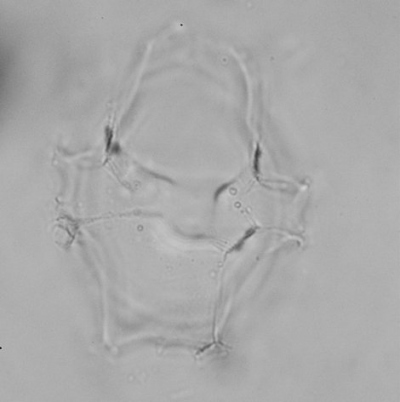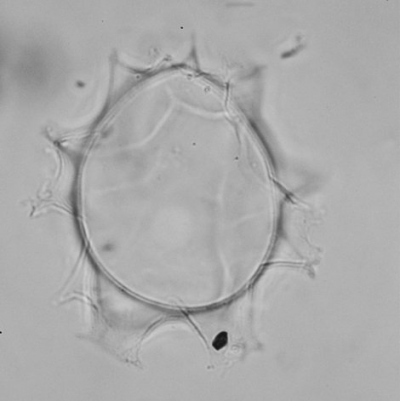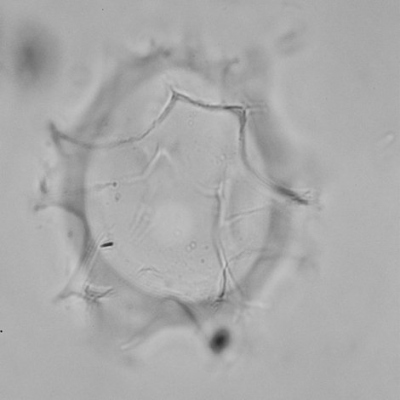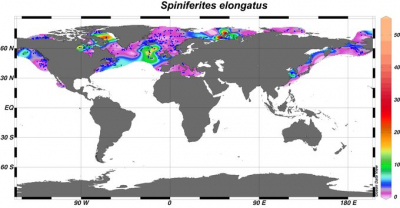Page path:
- Modern Dinocyst Key
- transparent cysts
- Septa and processes
- Elongate or cruciform cyst
- Spiniferites elongatus
Spiniferites elongatus
Zonneveld, K.A.F. and Pospelova V. (2015). A determination key for modern dinoflagellate cysts. Palynology 39 (3), 387- 407.

dorsal view
photo: Karin Zonneveld
photo: Karin Zonneveld

cross section
photo: Karin Zonneveld
photo: Karin Zonneveld

ventral view
photo: Karin Zonneveld
photo: Karin Zonneveld
Field characteristics
Spiniferites elongatus Reid 1974
Field characteristics:
Proximochorate cyst with an elongate to ellipsoid shape. Cyst wall is smooth. Tabulation is expressed by wide flaring sutural septa that attached close to the centre of plate areas, the place of attachment appearing as an oval line on each plate. Septa vary in height from high sutural flanges at the apex and antapex to lower septa near the cingulum. Sutural septa are membranous and hollow. Processes are trifurcate. Archeopyle is precingular (type P).
Dimensions: Cyst body: 26 to 42 (width) x 40 to 59 (length) µm; length of antapical processes: 12 to 16 µm; length of apical processes: 6 to 12 µm; length of lateral processes: 5 to 9 µm.
Motile affinity: Gonyaulax spinifera (Claparède et Lachmann 1859) Diesing 1866.
Cyst-theca relationship: Wall and Dale, 1967
Stratigraphic range: Upper Miocene to Recent.
Comparison with other species:
The characteristic feature of this species is its elongate form. The septa between the processes can vary much in height. S. elongates differs from Spiniferites frigidus as it is more rounded form. Intermediate specimens between the two species are common.
Field characteristics:
Proximochorate cyst with an elongate to ellipsoid shape. Cyst wall is smooth. Tabulation is expressed by wide flaring sutural septa that attached close to the centre of plate areas, the place of attachment appearing as an oval line on each plate. Septa vary in height from high sutural flanges at the apex and antapex to lower septa near the cingulum. Sutural septa are membranous and hollow. Processes are trifurcate. Archeopyle is precingular (type P).
Dimensions: Cyst body: 26 to 42 (width) x 40 to 59 (length) µm; length of antapical processes: 12 to 16 µm; length of apical processes: 6 to 12 µm; length of lateral processes: 5 to 9 µm.
Motile affinity: Gonyaulax spinifera (Claparède et Lachmann 1859) Diesing 1866.
Cyst-theca relationship: Wall and Dale, 1967
Stratigraphic range: Upper Miocene to Recent.
Comparison with other species:
The characteristic feature of this species is its elongate form. The septa between the processes can vary much in height. S. elongates differs from Spiniferites frigidus as it is more rounded form. Intermediate specimens between the two species are common.
Geographic distribution
Geographic distribution based on :
Zonneveld et al., 2013. Atlas of modern dinoflagellate cyst distribution based on 2405 datapoints. Review of Palaeobotany and Palynology, v. 191, 1-197
Zonneveld et al., 2013. Atlas of modern dinoflagellate cyst distribution based on 2405 datapoints. Review of Palaeobotany and Palynology, v. 191, 1-197
Spiniferites elongatus is a Northern Hemisphere species with a polar to sub-tropical distribution. It occurs in full-marine conditions, which may have (seasonally) reduced salinities as a result of ice melting and/or river discharge. Highest relative abundances occur in eutrophic settings such as the North Atlantic frontal systems. It only occurs where well ventilated bottom waters prevail.

Distribution:
Spiniferites elongatus is restricted to the Northern Hemispheric polar to subtropic regions. High relative abundances occur in the central North Atlantic Ocean near frontal systems, in the Baffin Bay (Labrador Sea) and in the Barents Sea (Arctic). It can account for up to 49% of the association. It can reach high relative abundances in coastal sites and it can be abundant in the central parts of the oceans.
Environmental parameter range:
SST: gradient is - 2.0 - 29.1°C (winter - summer) SSS: 9.8 - 39.2 (summer - summer), [P]: 0.09 - 1.73 μmol/l, [N]: 0.04 - 18.64 μmol/l, chlorophyll-a: 0.01 - 20.8 ml/l, bottom water [O2]: 0.9 - 8.2 ml/l.
Comparison with other records:
Spiniferites elongatus can be observed in regions with permanent sea ice cover but there is no evidence of a correlation between sea ice cover duration and relative abundances in the arctic region (de Vernal et al., 1998; Radi and de Vernal, 2008).
It occurs in fjords of Svalbard (Barents Sea) where it is produced in late summer - late autumn (Grøsfjeld et al., 2009, Howe et al., 2010)
Spiniferites elongatus is restricted to the Northern Hemispheric polar to subtropic regions. High relative abundances occur in the central North Atlantic Ocean near frontal systems, in the Baffin Bay (Labrador Sea) and in the Barents Sea (Arctic). It can account for up to 49% of the association. It can reach high relative abundances in coastal sites and it can be abundant in the central parts of the oceans.
Environmental parameter range:
SST: gradient is - 2.0 - 29.1°C (winter - summer) SSS: 9.8 - 39.2 (summer - summer), [P]: 0.09 - 1.73 μmol/l, [N]: 0.04 - 18.64 μmol/l, chlorophyll-a: 0.01 - 20.8 ml/l, bottom water [O2]: 0.9 - 8.2 ml/l.
Comparison with other records:
Spiniferites elongatus can be observed in regions with permanent sea ice cover but there is no evidence of a correlation between sea ice cover duration and relative abundances in the arctic region (de Vernal et al., 1998; Radi and de Vernal, 2008).
It occurs in fjords of Svalbard (Barents Sea) where it is produced in late summer - late autumn (Grøsfjeld et al., 2009, Howe et al., 2010)


